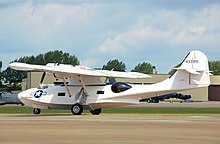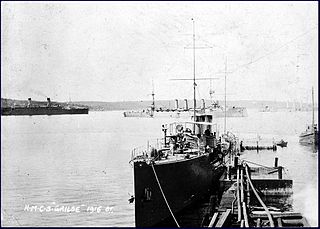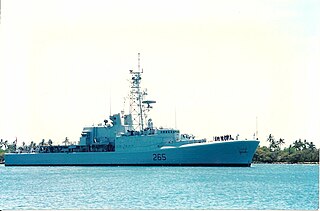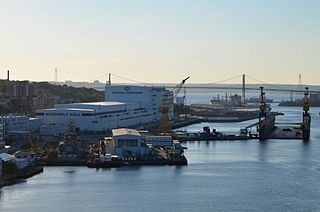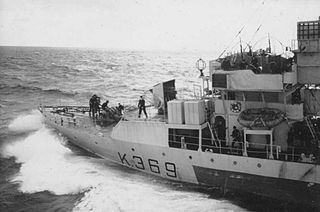Shipbuilding


In 1907, British shipbuilding and weapons manufacturing conglomerate Vickers Sons & Maxim began investigating possible locations for a shipyard in Montreal. [1] Vickers Sons & Maxim intended to use the shipyard as a repair facility for transatlantic shipping traffic entering Montreal. [2] Vickers Sons & Maxim was invited by the Government of Canada in 1911 to establish a Canadian division to manufacture vessels for the nascent Royal Canadian Navy. According to naval historian Marc Milner, "the Harbour Commission and the city of Maisonneuve offered Vickers a first-class location" to establish the yard, and "an extended lease on the land and deferred taxes." [3] Vickers Sons & Maxim established Canadian Vickers in June 1911 and constructed the shipyard between Rue Notre-Dame and rue Viau along the Saint Lawrence River (now Viterra Montreal Terminal). [1] Canadian Vickers ordered the construction of a large floating drydock, which was opened in 1912. [1] [3] Due to the establishment of Canadian Vickers, Montreal became one of Canada's leading shipbuilding centres. [1] The shipyard's first full year of operation was 1914, a year marked by the beginning of World War I. [2]
During World War I the yard assembled American-designed Holland 602 type submarines on behalf of the Royal Navy. [4] The hulls were Canadian-built, but the machinery and equipment were American. They were known as the British H-class submarine in the Royal Navy and were the first submarines to cross the Atlantic Ocean under their own power. Canadian Vickers (along with Polson Iron Works of Toronto) also constructed the first vessels specifically designed for the Royal Canadian Navy, the Battle-class naval trawlers. [5]
- H1 – Launched May 1915
- H2 – Launched June 1915
- H3 – Launched June 1915. Mined and sunk July 1916
- H4 – Launched June 1915
- H5 – Launched June 1915. Rammed and sunk March 1918
- H6 – Launched June 1915. Interned and purchased by the Dutch January 1916
- H7 – Launched June 1915
- H8 – Launched June 1915
- H9 – Launched June 1915
- H10 – Launched June 1915. Disappeared 1918
This shipyard would go on to produce many civilian and military ships in Canada, including:
- River-class frigates for the Canadian, British, and US navies.
- Flower-class corvettes for the Canadian, British, and US navies.
- St. Laurent-class destroyer
- Restigouche-class destroyer
- Mackenzie-class destroyer
- Canadian Coast Guard icebreakers
- floating drydock General Georges P Vanier in 1964 and renamed as Scotia Dock II by Halifax Shipyard; damaged and scrapped 2010.
Canadian Vickers also manufactured luxury yachts and vessels that were later converted as yachts:
- Bart Roberts – built in 1963 as icebreaker and converted as a yacht in 2001 [6]
- Club Atlantic – motor yacht built in 1967 [7]
- Christina O – built in 1943 as HMCS Stormont (K327) and converted as yacht in 1954; [8] renamed as Christina in 1954, Argo in 1978 and current named in 1998
Following World War I, labour militancy grew within Quebec. In June 1919, Canadian Vickers workers led labour action in Montreal as part of larger strike actions within the shipbuilding industry. The labour strike was a result of demands for maximum 8-hour shifts. Employees of Canadian Vickers coordinated with other work forces in Montreal, though shortly after it began, disagreements over a general strike led the labour action to falter. [9] The end of the First World War also saw a reduction of shipping orders and increased competition among shipbuilders. This led to consolidation among shipyards and Canadian Vickers' parent company, Vickers merged with Armstrong Whitworth to form Vickers-Armstrongs. In 1926, Frank Ross of Montreal Dry Dock and two business partners sought to acquire Canadian Vickers from its parent company. Negotiations began in March and were agreed to in November. In 1928, Ross merged Montreal Dry Dock with Canadian Vickers. During the 1930s, the yard survived the Great Depression with repair contracts and constructing manufacturing turbines and structural steel. [10]
The shipyard was reacquired by Vickers in 1956. [11] It was renamed Vickers Canada Limited in 1978 after being sold to Canadian interests and renamed several times again by the last owners Marine Industries, eventually (as Versatile Vickers Inc [12] [13] in 1981 and MIL Vickers in 1987). Shipbuiding operations ceased by 1988. [11]

